Literature Review: Women's Views on Alcohol Use During Pregnancy
VerifiedAdded on 2023/06/14
|30
|8824
|77
Literature Review
AI Summary
This literature review investigates women's perceptions of alcohol consumption during pregnancy, highlighting the rising rates of alcohol use among pregnant women and its associated complications like Fetal Alcohol Syndrome (FAS). It examines the social, cultural, and economic factors influencing women's drinking habits, including changes in gender roles and professional binge-drinking cultures. The review analyzes research articles from databases like PubMed and Scopus, focusing on primary research that captures women's views and experiences. It emphasizes the need for targeted preventive programs that address the underlying motivations for alcohol use during pregnancy, such as experiences of violence or lack of prenatal support, and aims to inform effective strategies to reduce the health burden and socioeconomic impacts of alcohol-related pregnancy complications. Desklib provides access to this and other solved assignments for students.
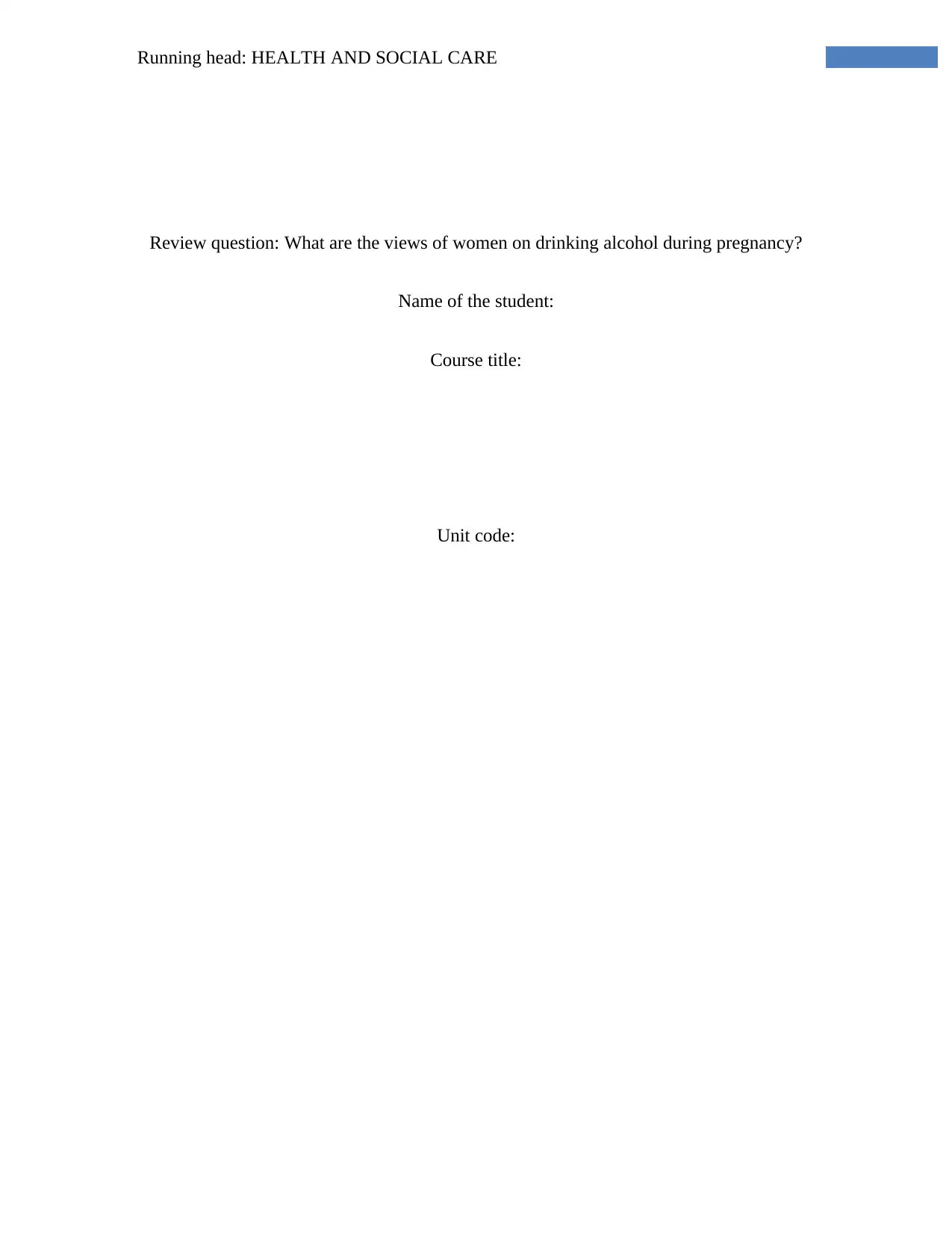
Running head: HEALTH AND SOCIAL CARE
Review question: What are the views of women on drinking alcohol during pregnancy?
Name of the student:
Course title:
Unit code:
Review question: What are the views of women on drinking alcohol during pregnancy?
Name of the student:
Course title:
Unit code:
Paraphrase This Document
Need a fresh take? Get an instant paraphrase of this document with our AI Paraphraser
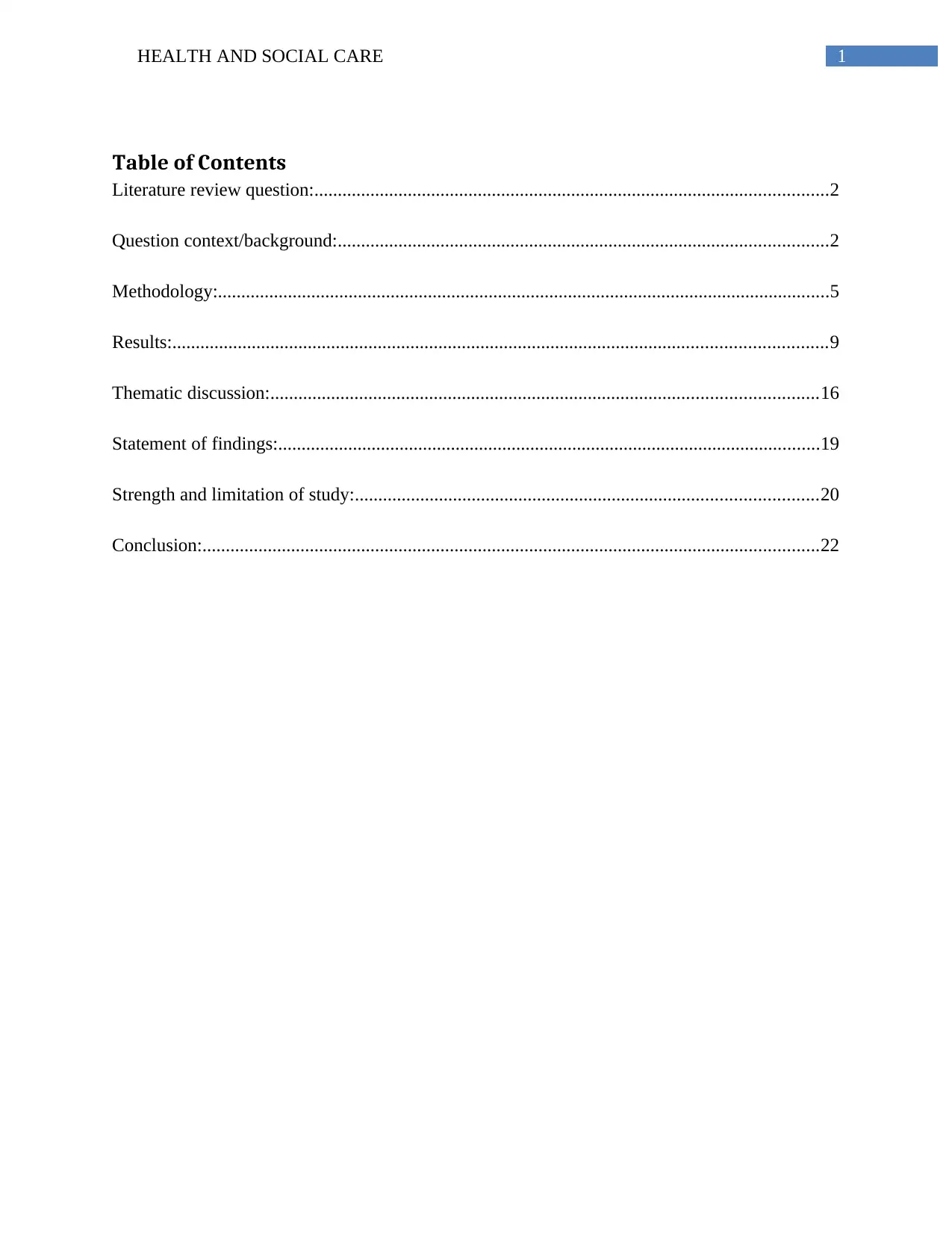
1HEALTH AND SOCIAL CARE
Table of Contents
Literature review question:..............................................................................................................2
Question context/background:.........................................................................................................2
Methodology:...................................................................................................................................5
Results:............................................................................................................................................9
Thematic discussion:.....................................................................................................................16
Statement of findings:....................................................................................................................19
Strength and limitation of study:...................................................................................................20
Conclusion:....................................................................................................................................22
Table of Contents
Literature review question:..............................................................................................................2
Question context/background:.........................................................................................................2
Methodology:...................................................................................................................................5
Results:............................................................................................................................................9
Thematic discussion:.....................................................................................................................16
Statement of findings:....................................................................................................................19
Strength and limitation of study:...................................................................................................20
Conclusion:....................................................................................................................................22
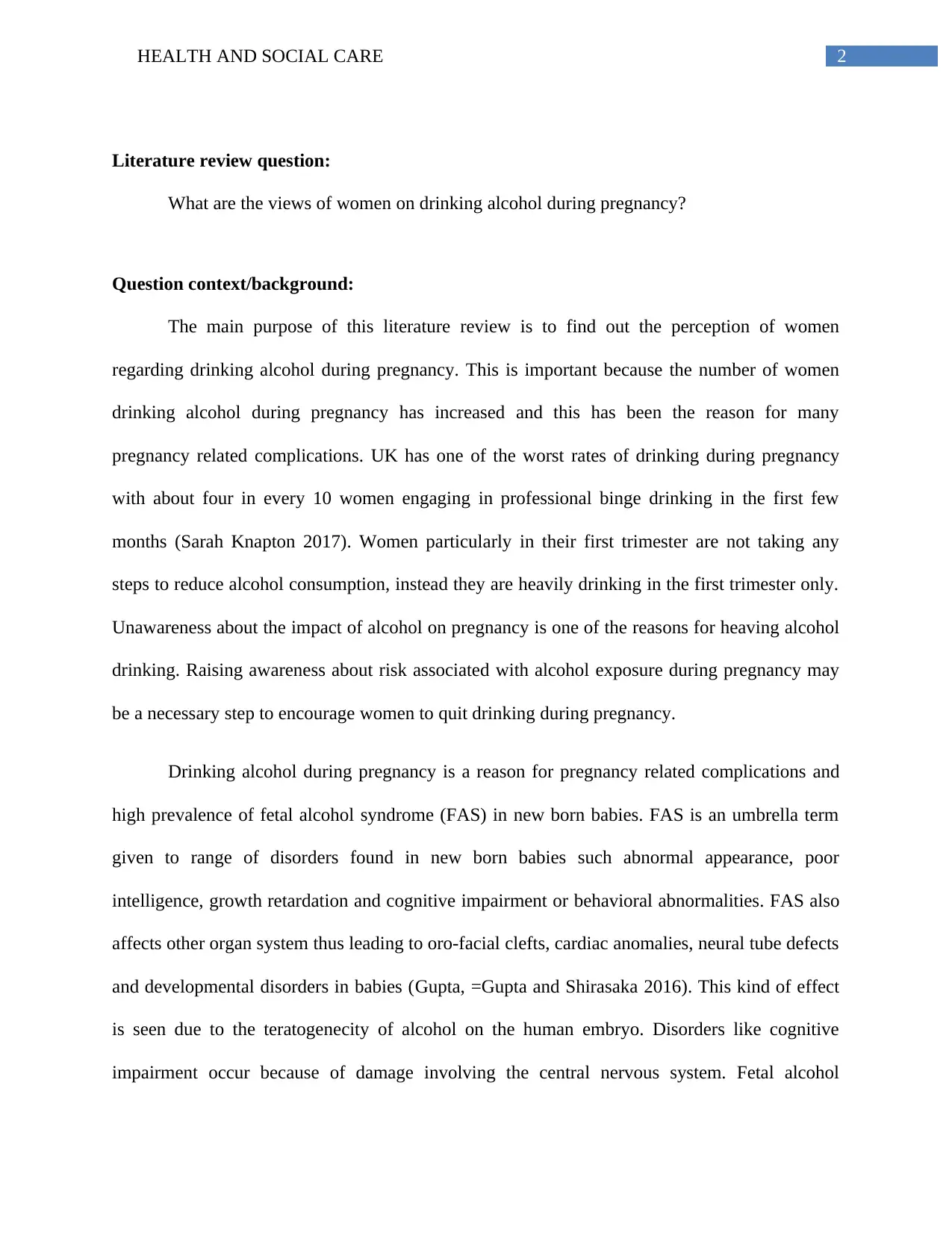
2HEALTH AND SOCIAL CARE
Literature review question:
What are the views of women on drinking alcohol during pregnancy?
Question context/background:
The main purpose of this literature review is to find out the perception of women
regarding drinking alcohol during pregnancy. This is important because the number of women
drinking alcohol during pregnancy has increased and this has been the reason for many
pregnancy related complications. UK has one of the worst rates of drinking during pregnancy
with about four in every 10 women engaging in professional binge drinking in the first few
months (Sarah Knapton 2017). Women particularly in their first trimester are not taking any
steps to reduce alcohol consumption, instead they are heavily drinking in the first trimester only.
Unawareness about the impact of alcohol on pregnancy is one of the reasons for heaving alcohol
drinking. Raising awareness about risk associated with alcohol exposure during pregnancy may
be a necessary step to encourage women to quit drinking during pregnancy.
Drinking alcohol during pregnancy is a reason for pregnancy related complications and
high prevalence of fetal alcohol syndrome (FAS) in new born babies. FAS is an umbrella term
given to range of disorders found in new born babies such abnormal appearance, poor
intelligence, growth retardation and cognitive impairment or behavioral abnormalities. FAS also
affects other organ system thus leading to oro-facial clefts, cardiac anomalies, neural tube defects
and developmental disorders in babies (Gupta, =Gupta and Shirasaka 2016). This kind of effect
is seen due to the teratogenecity of alcohol on the human embryo. Disorders like cognitive
impairment occur because of damage involving the central nervous system. Fetal alcohol
Literature review question:
What are the views of women on drinking alcohol during pregnancy?
Question context/background:
The main purpose of this literature review is to find out the perception of women
regarding drinking alcohol during pregnancy. This is important because the number of women
drinking alcohol during pregnancy has increased and this has been the reason for many
pregnancy related complications. UK has one of the worst rates of drinking during pregnancy
with about four in every 10 women engaging in professional binge drinking in the first few
months (Sarah Knapton 2017). Women particularly in their first trimester are not taking any
steps to reduce alcohol consumption, instead they are heavily drinking in the first trimester only.
Unawareness about the impact of alcohol on pregnancy is one of the reasons for heaving alcohol
drinking. Raising awareness about risk associated with alcohol exposure during pregnancy may
be a necessary step to encourage women to quit drinking during pregnancy.
Drinking alcohol during pregnancy is a reason for pregnancy related complications and
high prevalence of fetal alcohol syndrome (FAS) in new born babies. FAS is an umbrella term
given to range of disorders found in new born babies such abnormal appearance, poor
intelligence, growth retardation and cognitive impairment or behavioral abnormalities. FAS also
affects other organ system thus leading to oro-facial clefts, cardiac anomalies, neural tube defects
and developmental disorders in babies (Gupta, =Gupta and Shirasaka 2016). This kind of effect
is seen due to the teratogenecity of alcohol on the human embryo. Disorders like cognitive
impairment occur because of damage involving the central nervous system. Fetal alcohol
⊘ This is a preview!⊘
Do you want full access?
Subscribe today to unlock all pages.

Trusted by 1+ million students worldwide
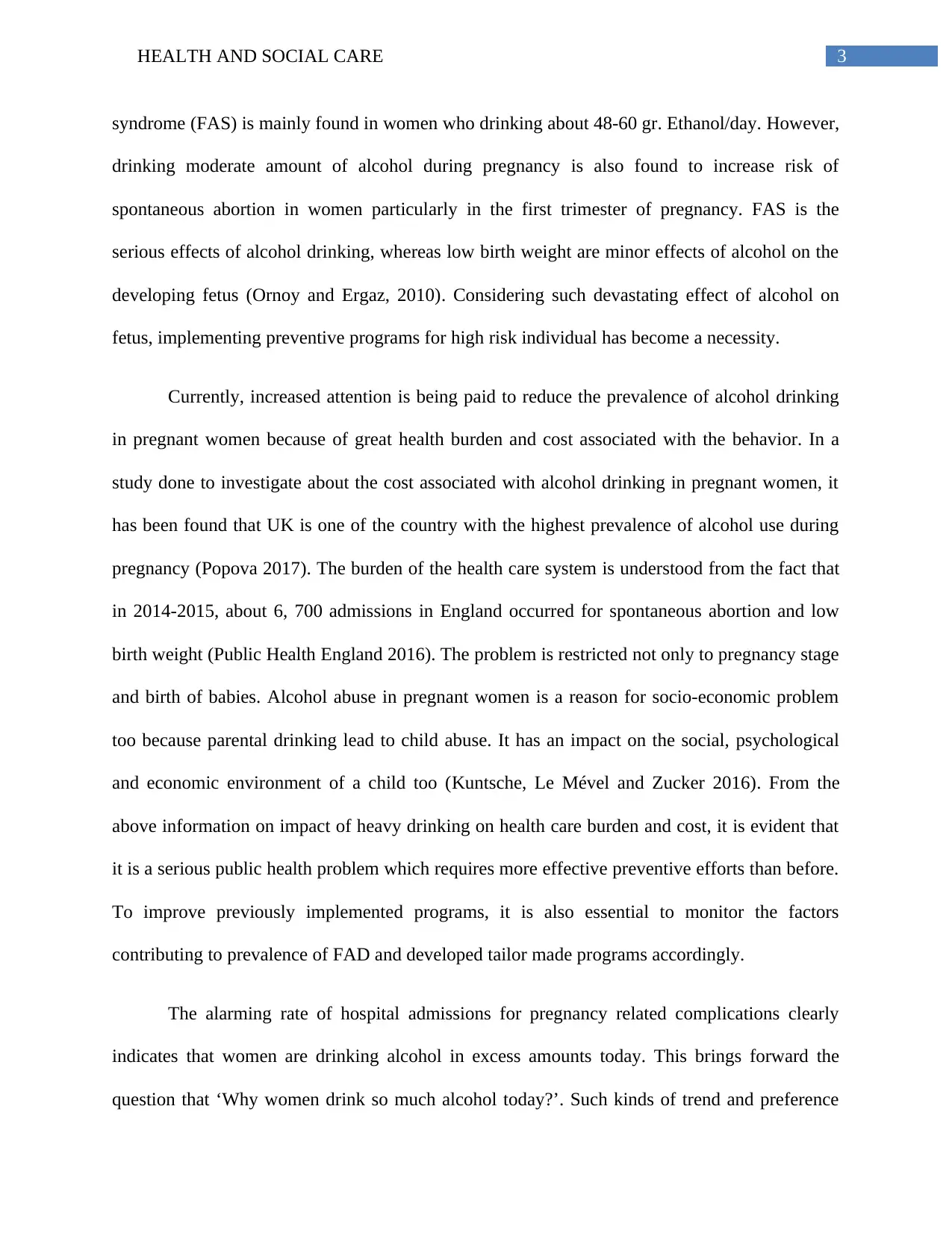
3HEALTH AND SOCIAL CARE
syndrome (FAS) is mainly found in women who drinking about 48-60 gr. Ethanol/day. However,
drinking moderate amount of alcohol during pregnancy is also found to increase risk of
spontaneous abortion in women particularly in the first trimester of pregnancy. FAS is the
serious effects of alcohol drinking, whereas low birth weight are minor effects of alcohol on the
developing fetus (Ornoy and Ergaz, 2010). Considering such devastating effect of alcohol on
fetus, implementing preventive programs for high risk individual has become a necessity.
Currently, increased attention is being paid to reduce the prevalence of alcohol drinking
in pregnant women because of great health burden and cost associated with the behavior. In a
study done to investigate about the cost associated with alcohol drinking in pregnant women, it
has been found that UK is one of the country with the highest prevalence of alcohol use during
pregnancy (Popova 2017). The burden of the health care system is understood from the fact that
in 2014-2015, about 6, 700 admissions in England occurred for spontaneous abortion and low
birth weight (Public Health England 2016). The problem is restricted not only to pregnancy stage
and birth of babies. Alcohol abuse in pregnant women is a reason for socio-economic problem
too because parental drinking lead to child abuse. It has an impact on the social, psychological
and economic environment of a child too (Kuntsche, Le Mével and Zucker 2016). From the
above information on impact of heavy drinking on health care burden and cost, it is evident that
it is a serious public health problem which requires more effective preventive efforts than before.
To improve previously implemented programs, it is also essential to monitor the factors
contributing to prevalence of FAD and developed tailor made programs accordingly.
The alarming rate of hospital admissions for pregnancy related complications clearly
indicates that women are drinking alcohol in excess amounts today. This brings forward the
question that ‘Why women drink so much alcohol today?’. Such kinds of trend and preference
syndrome (FAS) is mainly found in women who drinking about 48-60 gr. Ethanol/day. However,
drinking moderate amount of alcohol during pregnancy is also found to increase risk of
spontaneous abortion in women particularly in the first trimester of pregnancy. FAS is the
serious effects of alcohol drinking, whereas low birth weight are minor effects of alcohol on the
developing fetus (Ornoy and Ergaz, 2010). Considering such devastating effect of alcohol on
fetus, implementing preventive programs for high risk individual has become a necessity.
Currently, increased attention is being paid to reduce the prevalence of alcohol drinking
in pregnant women because of great health burden and cost associated with the behavior. In a
study done to investigate about the cost associated with alcohol drinking in pregnant women, it
has been found that UK is one of the country with the highest prevalence of alcohol use during
pregnancy (Popova 2017). The burden of the health care system is understood from the fact that
in 2014-2015, about 6, 700 admissions in England occurred for spontaneous abortion and low
birth weight (Public Health England 2016). The problem is restricted not only to pregnancy stage
and birth of babies. Alcohol abuse in pregnant women is a reason for socio-economic problem
too because parental drinking lead to child abuse. It has an impact on the social, psychological
and economic environment of a child too (Kuntsche, Le Mével and Zucker 2016). From the
above information on impact of heavy drinking on health care burden and cost, it is evident that
it is a serious public health problem which requires more effective preventive efforts than before.
To improve previously implemented programs, it is also essential to monitor the factors
contributing to prevalence of FAD and developed tailor made programs accordingly.
The alarming rate of hospital admissions for pregnancy related complications clearly
indicates that women are drinking alcohol in excess amounts today. This brings forward the
question that ‘Why women drink so much alcohol today?’. Such kinds of trend and preference
Paraphrase This Document
Need a fresh take? Get an instant paraphrase of this document with our AI Paraphraser
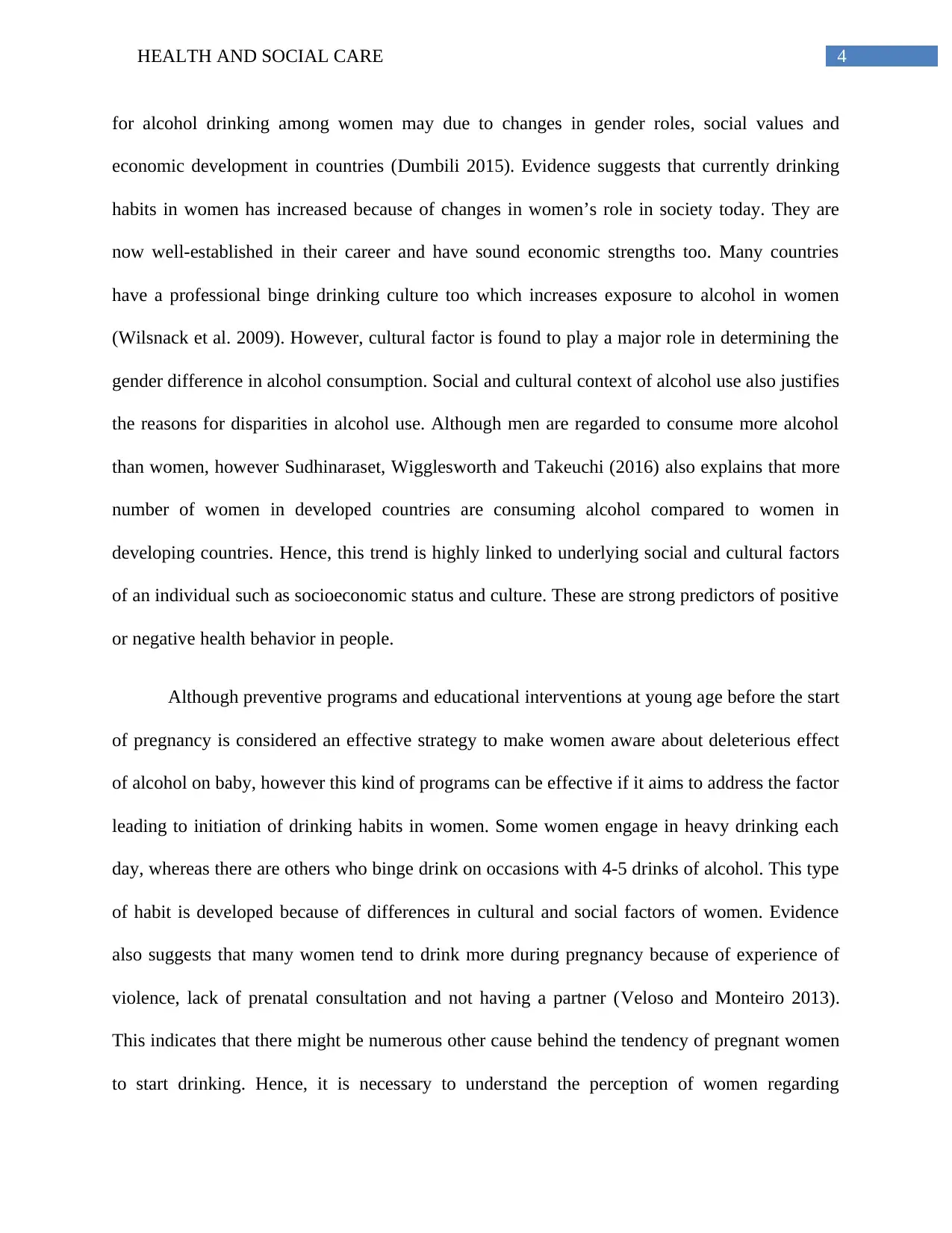
4HEALTH AND SOCIAL CARE
for alcohol drinking among women may due to changes in gender roles, social values and
economic development in countries (Dumbili 2015). Evidence suggests that currently drinking
habits in women has increased because of changes in women’s role in society today. They are
now well-established in their career and have sound economic strengths too. Many countries
have a professional binge drinking culture too which increases exposure to alcohol in women
(Wilsnack et al. 2009). However, cultural factor is found to play a major role in determining the
gender difference in alcohol consumption. Social and cultural context of alcohol use also justifies
the reasons for disparities in alcohol use. Although men are regarded to consume more alcohol
than women, however Sudhinaraset, Wigglesworth and Takeuchi (2016) also explains that more
number of women in developed countries are consuming alcohol compared to women in
developing countries. Hence, this trend is highly linked to underlying social and cultural factors
of an individual such as socioeconomic status and culture. These are strong predictors of positive
or negative health behavior in people.
Although preventive programs and educational interventions at young age before the start
of pregnancy is considered an effective strategy to make women aware about deleterious effect
of alcohol on baby, however this kind of programs can be effective if it aims to address the factor
leading to initiation of drinking habits in women. Some women engage in heavy drinking each
day, whereas there are others who binge drink on occasions with 4-5 drinks of alcohol. This type
of habit is developed because of differences in cultural and social factors of women. Evidence
also suggests that many women tend to drink more during pregnancy because of experience of
violence, lack of prenatal consultation and not having a partner (Veloso and Monteiro 2013).
This indicates that there might be numerous other cause behind the tendency of pregnant women
to start drinking. Hence, it is necessary to understand the perception of women regarding
for alcohol drinking among women may due to changes in gender roles, social values and
economic development in countries (Dumbili 2015). Evidence suggests that currently drinking
habits in women has increased because of changes in women’s role in society today. They are
now well-established in their career and have sound economic strengths too. Many countries
have a professional binge drinking culture too which increases exposure to alcohol in women
(Wilsnack et al. 2009). However, cultural factor is found to play a major role in determining the
gender difference in alcohol consumption. Social and cultural context of alcohol use also justifies
the reasons for disparities in alcohol use. Although men are regarded to consume more alcohol
than women, however Sudhinaraset, Wigglesworth and Takeuchi (2016) also explains that more
number of women in developed countries are consuming alcohol compared to women in
developing countries. Hence, this trend is highly linked to underlying social and cultural factors
of an individual such as socioeconomic status and culture. These are strong predictors of positive
or negative health behavior in people.
Although preventive programs and educational interventions at young age before the start
of pregnancy is considered an effective strategy to make women aware about deleterious effect
of alcohol on baby, however this kind of programs can be effective if it aims to address the factor
leading to initiation of drinking habits in women. Some women engage in heavy drinking each
day, whereas there are others who binge drink on occasions with 4-5 drinks of alcohol. This type
of habit is developed because of differences in cultural and social factors of women. Evidence
also suggests that many women tend to drink more during pregnancy because of experience of
violence, lack of prenatal consultation and not having a partner (Veloso and Monteiro 2013).
This indicates that there might be numerous other cause behind the tendency of pregnant women
to start drinking. Hence, it is necessary to understand the perception of women regarding
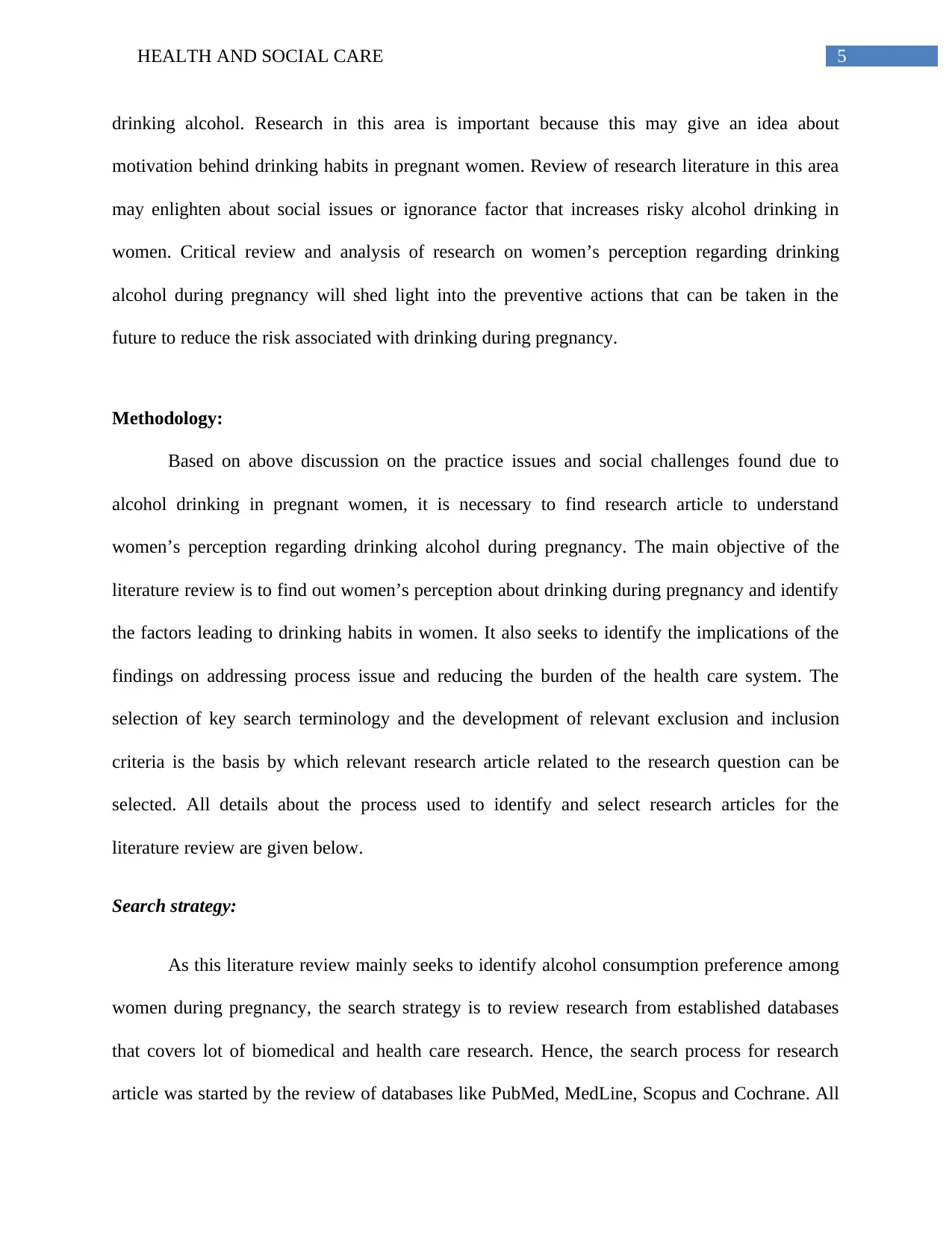
5HEALTH AND SOCIAL CARE
drinking alcohol. Research in this area is important because this may give an idea about
motivation behind drinking habits in pregnant women. Review of research literature in this area
may enlighten about social issues or ignorance factor that increases risky alcohol drinking in
women. Critical review and analysis of research on women’s perception regarding drinking
alcohol during pregnancy will shed light into the preventive actions that can be taken in the
future to reduce the risk associated with drinking during pregnancy.
Methodology:
Based on above discussion on the practice issues and social challenges found due to
alcohol drinking in pregnant women, it is necessary to find research article to understand
women’s perception regarding drinking alcohol during pregnancy. The main objective of the
literature review is to find out women’s perception about drinking during pregnancy and identify
the factors leading to drinking habits in women. It also seeks to identify the implications of the
findings on addressing process issue and reducing the burden of the health care system. The
selection of key search terminology and the development of relevant exclusion and inclusion
criteria is the basis by which relevant research article related to the research question can be
selected. All details about the process used to identify and select research articles for the
literature review are given below.
Search strategy:
As this literature review mainly seeks to identify alcohol consumption preference among
women during pregnancy, the search strategy is to review research from established databases
that covers lot of biomedical and health care research. Hence, the search process for research
article was started by the review of databases like PubMed, MedLine, Scopus and Cochrane. All
drinking alcohol. Research in this area is important because this may give an idea about
motivation behind drinking habits in pregnant women. Review of research literature in this area
may enlighten about social issues or ignorance factor that increases risky alcohol drinking in
women. Critical review and analysis of research on women’s perception regarding drinking
alcohol during pregnancy will shed light into the preventive actions that can be taken in the
future to reduce the risk associated with drinking during pregnancy.
Methodology:
Based on above discussion on the practice issues and social challenges found due to
alcohol drinking in pregnant women, it is necessary to find research article to understand
women’s perception regarding drinking alcohol during pregnancy. The main objective of the
literature review is to find out women’s perception about drinking during pregnancy and identify
the factors leading to drinking habits in women. It also seeks to identify the implications of the
findings on addressing process issue and reducing the burden of the health care system. The
selection of key search terminology and the development of relevant exclusion and inclusion
criteria is the basis by which relevant research article related to the research question can be
selected. All details about the process used to identify and select research articles for the
literature review are given below.
Search strategy:
As this literature review mainly seeks to identify alcohol consumption preference among
women during pregnancy, the search strategy is to review research from established databases
that covers lot of biomedical and health care research. Hence, the search process for research
article was started by the review of databases like PubMed, MedLine, Scopus and Cochrane. All
⊘ This is a preview!⊘
Do you want full access?
Subscribe today to unlock all pages.

Trusted by 1+ million students worldwide
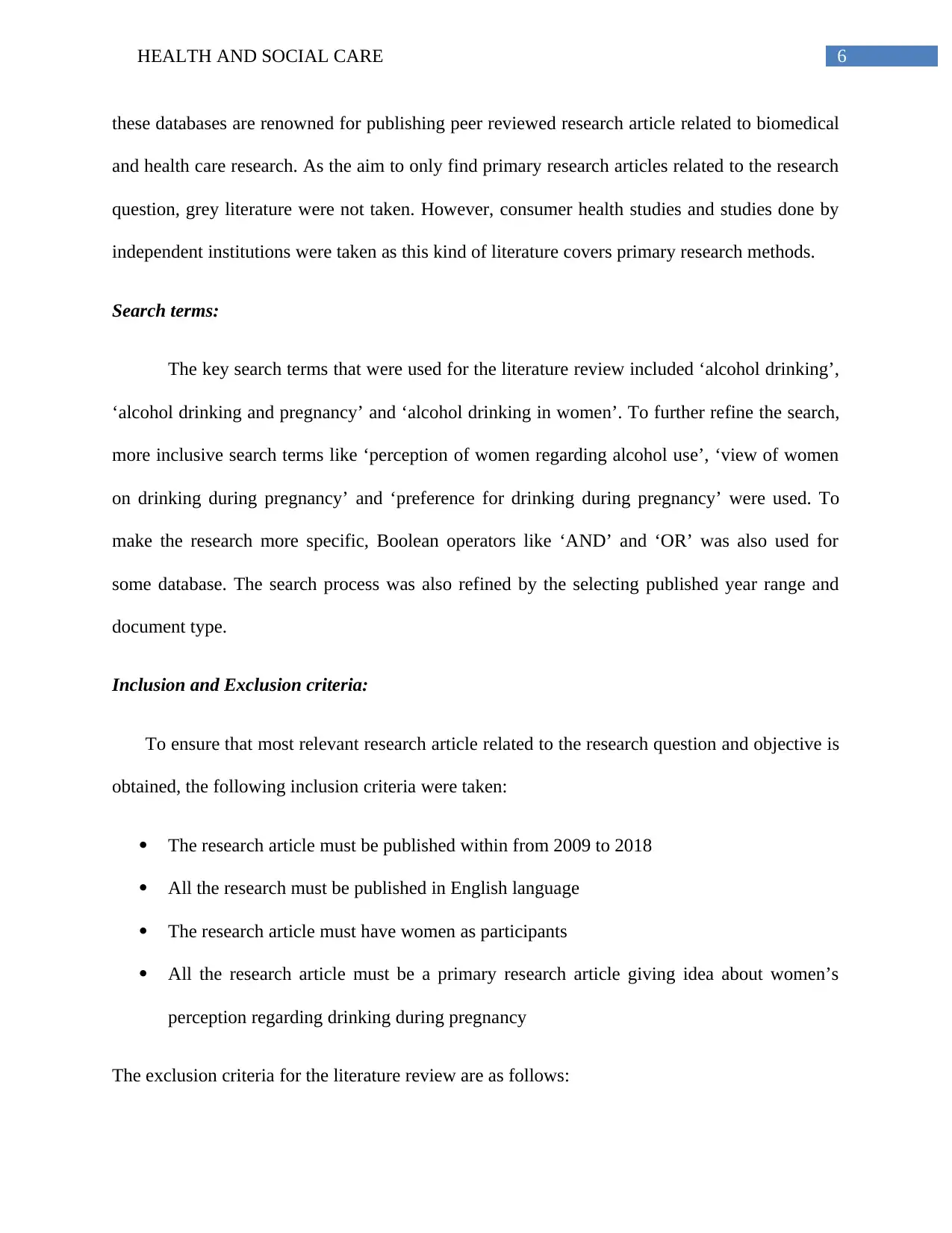
6HEALTH AND SOCIAL CARE
these databases are renowned for publishing peer reviewed research article related to biomedical
and health care research. As the aim to only find primary research articles related to the research
question, grey literature were not taken. However, consumer health studies and studies done by
independent institutions were taken as this kind of literature covers primary research methods.
Search terms:
The key search terms that were used for the literature review included ‘alcohol drinking’,
‘alcohol drinking and pregnancy’ and ‘alcohol drinking in women’. To further refine the search,
more inclusive search terms like ‘perception of women regarding alcohol use’, ‘view of women
on drinking during pregnancy’ and ‘preference for drinking during pregnancy’ were used. To
make the research more specific, Boolean operators like ‘AND’ and ‘OR’ was also used for
some database. The search process was also refined by the selecting published year range and
document type.
Inclusion and Exclusion criteria:
To ensure that most relevant research article related to the research question and objective is
obtained, the following inclusion criteria were taken:
The research article must be published within from 2009 to 2018
All the research must be published in English language
The research article must have women as participants
All the research article must be a primary research article giving idea about women’s
perception regarding drinking during pregnancy
The exclusion criteria for the literature review are as follows:
these databases are renowned for publishing peer reviewed research article related to biomedical
and health care research. As the aim to only find primary research articles related to the research
question, grey literature were not taken. However, consumer health studies and studies done by
independent institutions were taken as this kind of literature covers primary research methods.
Search terms:
The key search terms that were used for the literature review included ‘alcohol drinking’,
‘alcohol drinking and pregnancy’ and ‘alcohol drinking in women’. To further refine the search,
more inclusive search terms like ‘perception of women regarding alcohol use’, ‘view of women
on drinking during pregnancy’ and ‘preference for drinking during pregnancy’ were used. To
make the research more specific, Boolean operators like ‘AND’ and ‘OR’ was also used for
some database. The search process was also refined by the selecting published year range and
document type.
Inclusion and Exclusion criteria:
To ensure that most relevant research article related to the research question and objective is
obtained, the following inclusion criteria were taken:
The research article must be published within from 2009 to 2018
All the research must be published in English language
The research article must have women as participants
All the research article must be a primary research article giving idea about women’s
perception regarding drinking during pregnancy
The exclusion criteria for the literature review are as follows:
Paraphrase This Document
Need a fresh take? Get an instant paraphrase of this document with our AI Paraphraser
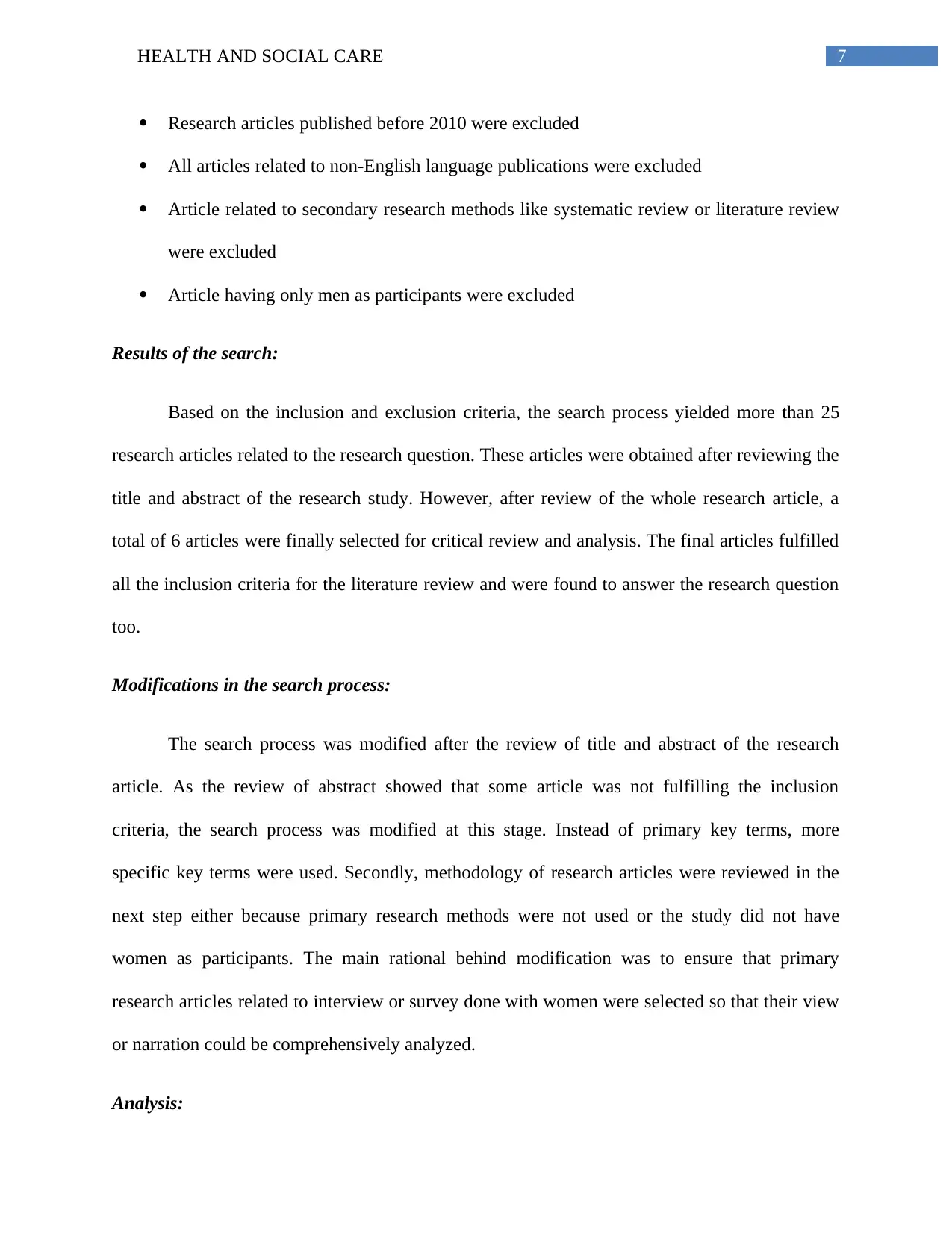
7HEALTH AND SOCIAL CARE
Research articles published before 2010 were excluded
All articles related to non-English language publications were excluded
Article related to secondary research methods like systematic review or literature review
were excluded
Article having only men as participants were excluded
Results of the search:
Based on the inclusion and exclusion criteria, the search process yielded more than 25
research articles related to the research question. These articles were obtained after reviewing the
title and abstract of the research study. However, after review of the whole research article, a
total of 6 articles were finally selected for critical review and analysis. The final articles fulfilled
all the inclusion criteria for the literature review and were found to answer the research question
too.
Modifications in the search process:
The search process was modified after the review of title and abstract of the research
article. As the review of abstract showed that some article was not fulfilling the inclusion
criteria, the search process was modified at this stage. Instead of primary key terms, more
specific key terms were used. Secondly, methodology of research articles were reviewed in the
next step either because primary research methods were not used or the study did not have
women as participants. The main rational behind modification was to ensure that primary
research articles related to interview or survey done with women were selected so that their view
or narration could be comprehensively analyzed.
Analysis:
Research articles published before 2010 were excluded
All articles related to non-English language publications were excluded
Article related to secondary research methods like systematic review or literature review
were excluded
Article having only men as participants were excluded
Results of the search:
Based on the inclusion and exclusion criteria, the search process yielded more than 25
research articles related to the research question. These articles were obtained after reviewing the
title and abstract of the research study. However, after review of the whole research article, a
total of 6 articles were finally selected for critical review and analysis. The final articles fulfilled
all the inclusion criteria for the literature review and were found to answer the research question
too.
Modifications in the search process:
The search process was modified after the review of title and abstract of the research
article. As the review of abstract showed that some article was not fulfilling the inclusion
criteria, the search process was modified at this stage. Instead of primary key terms, more
specific key terms were used. Secondly, methodology of research articles were reviewed in the
next step either because primary research methods were not used or the study did not have
women as participants. The main rational behind modification was to ensure that primary
research articles related to interview or survey done with women were selected so that their view
or narration could be comprehensively analyzed.
Analysis:
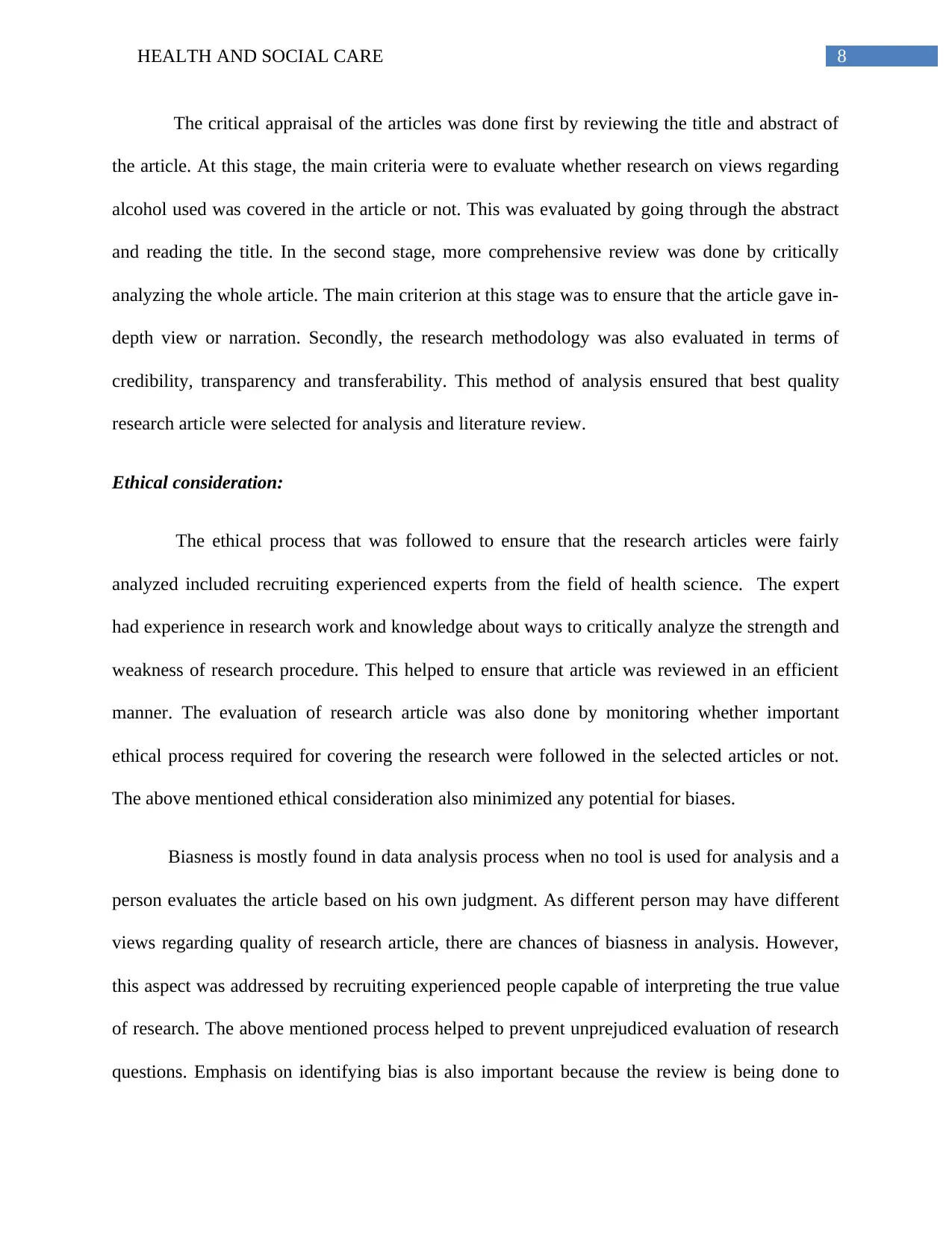
8HEALTH AND SOCIAL CARE
The critical appraisal of the articles was done first by reviewing the title and abstract of
the article. At this stage, the main criteria were to evaluate whether research on views regarding
alcohol used was covered in the article or not. This was evaluated by going through the abstract
and reading the title. In the second stage, more comprehensive review was done by critically
analyzing the whole article. The main criterion at this stage was to ensure that the article gave in-
depth view or narration. Secondly, the research methodology was also evaluated in terms of
credibility, transparency and transferability. This method of analysis ensured that best quality
research article were selected for analysis and literature review.
Ethical consideration:
The ethical process that was followed to ensure that the research articles were fairly
analyzed included recruiting experienced experts from the field of health science. The expert
had experience in research work and knowledge about ways to critically analyze the strength and
weakness of research procedure. This helped to ensure that article was reviewed in an efficient
manner. The evaluation of research article was also done by monitoring whether important
ethical process required for covering the research were followed in the selected articles or not.
The above mentioned ethical consideration also minimized any potential for biases.
Biasness is mostly found in data analysis process when no tool is used for analysis and a
person evaluates the article based on his own judgment. As different person may have different
views regarding quality of research article, there are chances of biasness in analysis. However,
this aspect was addressed by recruiting experienced people capable of interpreting the true value
of research. The above mentioned process helped to prevent unprejudiced evaluation of research
questions. Emphasis on identifying bias is also important because the review is being done to
The critical appraisal of the articles was done first by reviewing the title and abstract of
the article. At this stage, the main criteria were to evaluate whether research on views regarding
alcohol used was covered in the article or not. This was evaluated by going through the abstract
and reading the title. In the second stage, more comprehensive review was done by critically
analyzing the whole article. The main criterion at this stage was to ensure that the article gave in-
depth view or narration. Secondly, the research methodology was also evaluated in terms of
credibility, transparency and transferability. This method of analysis ensured that best quality
research article were selected for analysis and literature review.
Ethical consideration:
The ethical process that was followed to ensure that the research articles were fairly
analyzed included recruiting experienced experts from the field of health science. The expert
had experience in research work and knowledge about ways to critically analyze the strength and
weakness of research procedure. This helped to ensure that article was reviewed in an efficient
manner. The evaluation of research article was also done by monitoring whether important
ethical process required for covering the research were followed in the selected articles or not.
The above mentioned ethical consideration also minimized any potential for biases.
Biasness is mostly found in data analysis process when no tool is used for analysis and a
person evaluates the article based on his own judgment. As different person may have different
views regarding quality of research article, there are chances of biasness in analysis. However,
this aspect was addressed by recruiting experienced people capable of interpreting the true value
of research. The above mentioned process helped to prevent unprejudiced evaluation of research
questions. Emphasis on identifying bias is also important because the review is being done to
⊘ This is a preview!⊘
Do you want full access?
Subscribe today to unlock all pages.

Trusted by 1+ million students worldwide
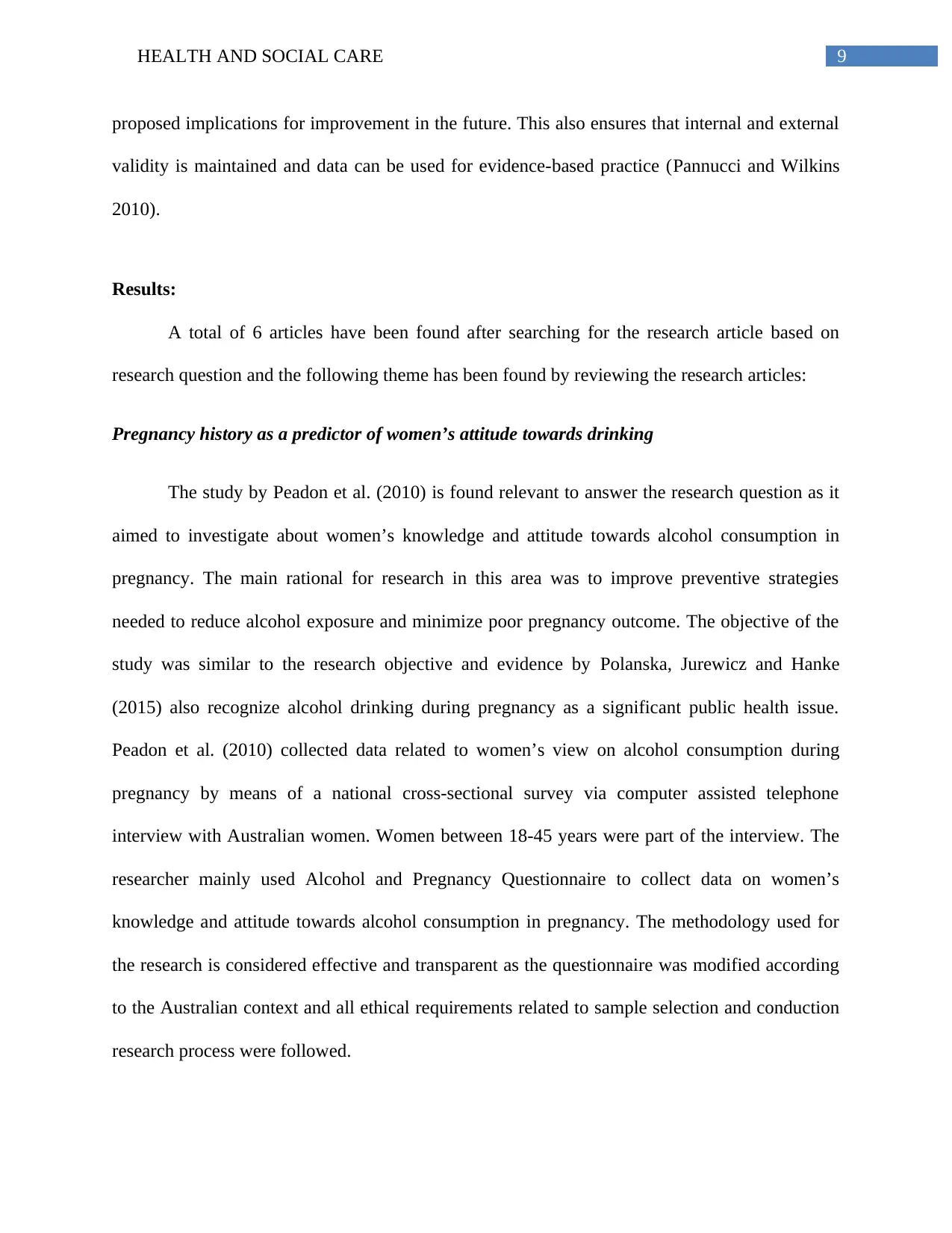
9HEALTH AND SOCIAL CARE
proposed implications for improvement in the future. This also ensures that internal and external
validity is maintained and data can be used for evidence-based practice (Pannucci and Wilkins
2010).
Results:
A total of 6 articles have been found after searching for the research article based on
research question and the following theme has been found by reviewing the research articles:
Pregnancy history as a predictor of women’s attitude towards drinking
The study by Peadon et al. (2010) is found relevant to answer the research question as it
aimed to investigate about women’s knowledge and attitude towards alcohol consumption in
pregnancy. The main rational for research in this area was to improve preventive strategies
needed to reduce alcohol exposure and minimize poor pregnancy outcome. The objective of the
study was similar to the research objective and evidence by Polanska, Jurewicz and Hanke
(2015) also recognize alcohol drinking during pregnancy as a significant public health issue.
Peadon et al. (2010) collected data related to women’s view on alcohol consumption during
pregnancy by means of a national cross-sectional survey via computer assisted telephone
interview with Australian women. Women between 18-45 years were part of the interview. The
researcher mainly used Alcohol and Pregnancy Questionnaire to collect data on women’s
knowledge and attitude towards alcohol consumption in pregnancy. The methodology used for
the research is considered effective and transparent as the questionnaire was modified according
to the Australian context and all ethical requirements related to sample selection and conduction
research process were followed.
proposed implications for improvement in the future. This also ensures that internal and external
validity is maintained and data can be used for evidence-based practice (Pannucci and Wilkins
2010).
Results:
A total of 6 articles have been found after searching for the research article based on
research question and the following theme has been found by reviewing the research articles:
Pregnancy history as a predictor of women’s attitude towards drinking
The study by Peadon et al. (2010) is found relevant to answer the research question as it
aimed to investigate about women’s knowledge and attitude towards alcohol consumption in
pregnancy. The main rational for research in this area was to improve preventive strategies
needed to reduce alcohol exposure and minimize poor pregnancy outcome. The objective of the
study was similar to the research objective and evidence by Polanska, Jurewicz and Hanke
(2015) also recognize alcohol drinking during pregnancy as a significant public health issue.
Peadon et al. (2010) collected data related to women’s view on alcohol consumption during
pregnancy by means of a national cross-sectional survey via computer assisted telephone
interview with Australian women. Women between 18-45 years were part of the interview. The
researcher mainly used Alcohol and Pregnancy Questionnaire to collect data on women’s
knowledge and attitude towards alcohol consumption in pregnancy. The methodology used for
the research is considered effective and transparent as the questionnaire was modified according
to the Australian context and all ethical requirements related to sample selection and conduction
research process were followed.
Paraphrase This Document
Need a fresh take? Get an instant paraphrase of this document with our AI Paraphraser
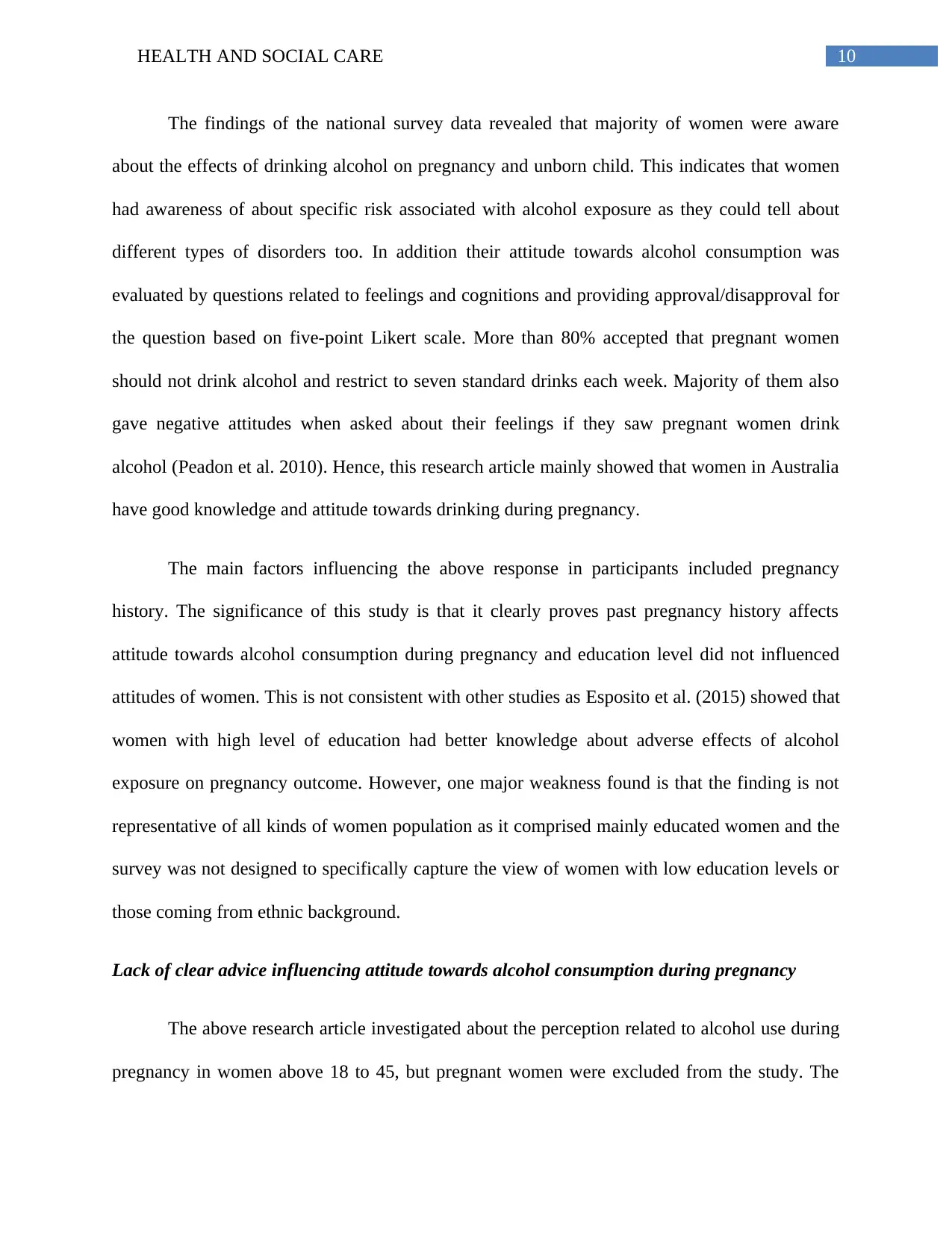
10HEALTH AND SOCIAL CARE
The findings of the national survey data revealed that majority of women were aware
about the effects of drinking alcohol on pregnancy and unborn child. This indicates that women
had awareness of about specific risk associated with alcohol exposure as they could tell about
different types of disorders too. In addition their attitude towards alcohol consumption was
evaluated by questions related to feelings and cognitions and providing approval/disapproval for
the question based on five-point Likert scale. More than 80% accepted that pregnant women
should not drink alcohol and restrict to seven standard drinks each week. Majority of them also
gave negative attitudes when asked about their feelings if they saw pregnant women drink
alcohol (Peadon et al. 2010). Hence, this research article mainly showed that women in Australia
have good knowledge and attitude towards drinking during pregnancy.
The main factors influencing the above response in participants included pregnancy
history. The significance of this study is that it clearly proves past pregnancy history affects
attitude towards alcohol consumption during pregnancy and education level did not influenced
attitudes of women. This is not consistent with other studies as Esposito et al. (2015) showed that
women with high level of education had better knowledge about adverse effects of alcohol
exposure on pregnancy outcome. However, one major weakness found is that the finding is not
representative of all kinds of women population as it comprised mainly educated women and the
survey was not designed to specifically capture the view of women with low education levels or
those coming from ethnic background.
Lack of clear advice influencing attitude towards alcohol consumption during pregnancy
The above research article investigated about the perception related to alcohol use during
pregnancy in women above 18 to 45, but pregnant women were excluded from the study. The
The findings of the national survey data revealed that majority of women were aware
about the effects of drinking alcohol on pregnancy and unborn child. This indicates that women
had awareness of about specific risk associated with alcohol exposure as they could tell about
different types of disorders too. In addition their attitude towards alcohol consumption was
evaluated by questions related to feelings and cognitions and providing approval/disapproval for
the question based on five-point Likert scale. More than 80% accepted that pregnant women
should not drink alcohol and restrict to seven standard drinks each week. Majority of them also
gave negative attitudes when asked about their feelings if they saw pregnant women drink
alcohol (Peadon et al. 2010). Hence, this research article mainly showed that women in Australia
have good knowledge and attitude towards drinking during pregnancy.
The main factors influencing the above response in participants included pregnancy
history. The significance of this study is that it clearly proves past pregnancy history affects
attitude towards alcohol consumption during pregnancy and education level did not influenced
attitudes of women. This is not consistent with other studies as Esposito et al. (2015) showed that
women with high level of education had better knowledge about adverse effects of alcohol
exposure on pregnancy outcome. However, one major weakness found is that the finding is not
representative of all kinds of women population as it comprised mainly educated women and the
survey was not designed to specifically capture the view of women with low education levels or
those coming from ethnic background.
Lack of clear advice influencing attitude towards alcohol consumption during pregnancy
The above research article investigated about the perception related to alcohol use during
pregnancy in women above 18 to 45, but pregnant women were excluded from the study. The
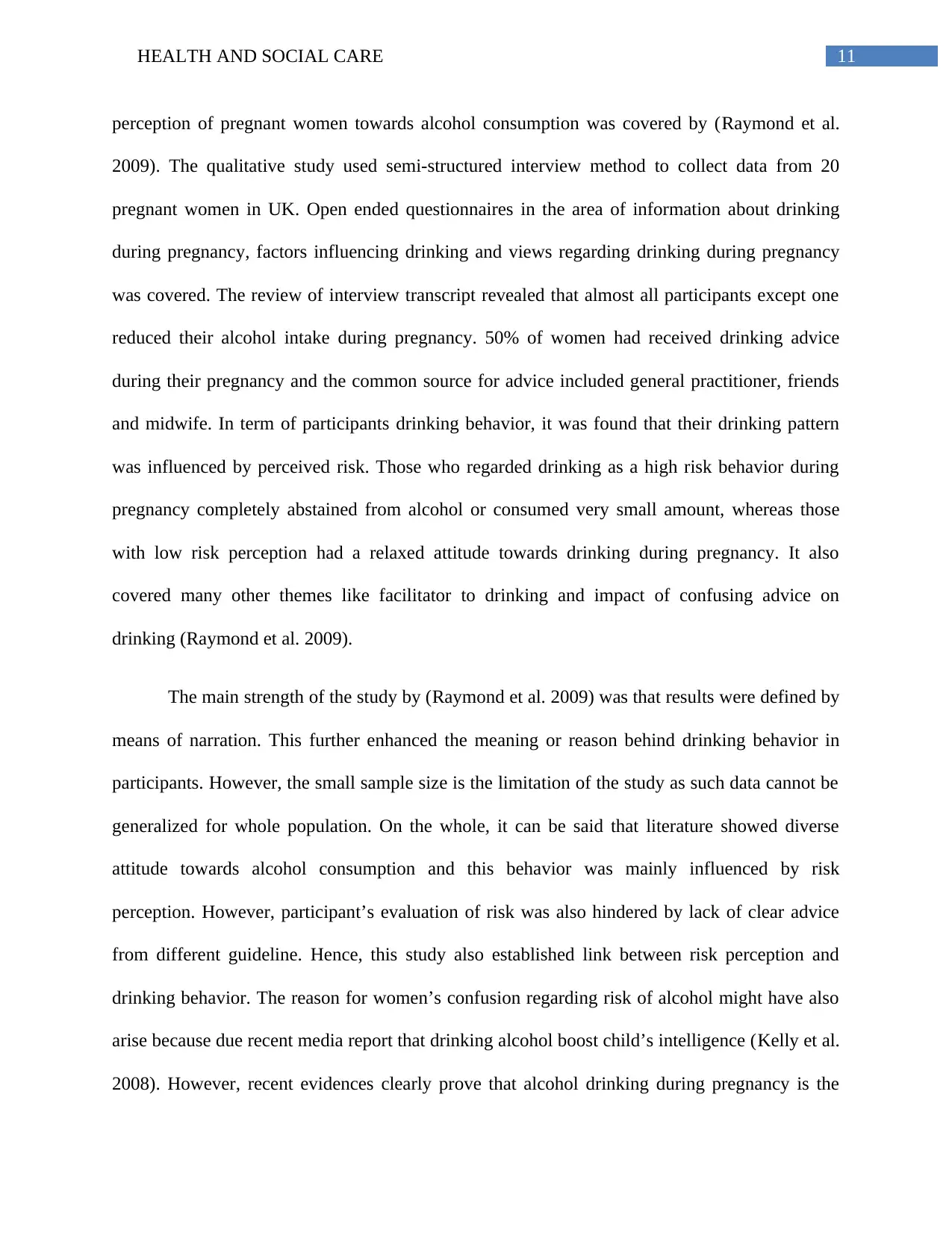
11HEALTH AND SOCIAL CARE
perception of pregnant women towards alcohol consumption was covered by (Raymond et al.
2009). The qualitative study used semi-structured interview method to collect data from 20
pregnant women in UK. Open ended questionnaires in the area of information about drinking
during pregnancy, factors influencing drinking and views regarding drinking during pregnancy
was covered. The review of interview transcript revealed that almost all participants except one
reduced their alcohol intake during pregnancy. 50% of women had received drinking advice
during their pregnancy and the common source for advice included general practitioner, friends
and midwife. In term of participants drinking behavior, it was found that their drinking pattern
was influenced by perceived risk. Those who regarded drinking as a high risk behavior during
pregnancy completely abstained from alcohol or consumed very small amount, whereas those
with low risk perception had a relaxed attitude towards drinking during pregnancy. It also
covered many other themes like facilitator to drinking and impact of confusing advice on
drinking (Raymond et al. 2009).
The main strength of the study by (Raymond et al. 2009) was that results were defined by
means of narration. This further enhanced the meaning or reason behind drinking behavior in
participants. However, the small sample size is the limitation of the study as such data cannot be
generalized for whole population. On the whole, it can be said that literature showed diverse
attitude towards alcohol consumption and this behavior was mainly influenced by risk
perception. However, participant’s evaluation of risk was also hindered by lack of clear advice
from different guideline. Hence, this study also established link between risk perception and
drinking behavior. The reason for women’s confusion regarding risk of alcohol might have also
arise because due recent media report that drinking alcohol boost child’s intelligence (Kelly et al.
2008). However, recent evidences clearly prove that alcohol drinking during pregnancy is the
perception of pregnant women towards alcohol consumption was covered by (Raymond et al.
2009). The qualitative study used semi-structured interview method to collect data from 20
pregnant women in UK. Open ended questionnaires in the area of information about drinking
during pregnancy, factors influencing drinking and views regarding drinking during pregnancy
was covered. The review of interview transcript revealed that almost all participants except one
reduced their alcohol intake during pregnancy. 50% of women had received drinking advice
during their pregnancy and the common source for advice included general practitioner, friends
and midwife. In term of participants drinking behavior, it was found that their drinking pattern
was influenced by perceived risk. Those who regarded drinking as a high risk behavior during
pregnancy completely abstained from alcohol or consumed very small amount, whereas those
with low risk perception had a relaxed attitude towards drinking during pregnancy. It also
covered many other themes like facilitator to drinking and impact of confusing advice on
drinking (Raymond et al. 2009).
The main strength of the study by (Raymond et al. 2009) was that results were defined by
means of narration. This further enhanced the meaning or reason behind drinking behavior in
participants. However, the small sample size is the limitation of the study as such data cannot be
generalized for whole population. On the whole, it can be said that literature showed diverse
attitude towards alcohol consumption and this behavior was mainly influenced by risk
perception. However, participant’s evaluation of risk was also hindered by lack of clear advice
from different guideline. Hence, this study also established link between risk perception and
drinking behavior. The reason for women’s confusion regarding risk of alcohol might have also
arise because due recent media report that drinking alcohol boost child’s intelligence (Kelly et al.
2008). However, recent evidences clearly prove that alcohol drinking during pregnancy is the
⊘ This is a preview!⊘
Do you want full access?
Subscribe today to unlock all pages.

Trusted by 1+ million students worldwide
1 out of 30
Related Documents
Your All-in-One AI-Powered Toolkit for Academic Success.
+13062052269
info@desklib.com
Available 24*7 on WhatsApp / Email
![[object Object]](/_next/static/media/star-bottom.7253800d.svg)
Unlock your academic potential
Copyright © 2020–2025 A2Z Services. All Rights Reserved. Developed and managed by ZUCOL.





